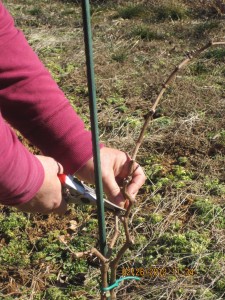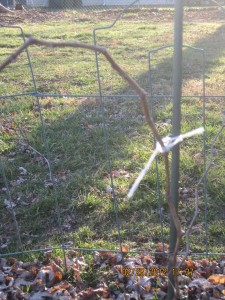Dormant Winter Pruning — and other Vineyard Considerations
After a long winter that sometimes seemed like it would never end, spring planting is just around the corner. And despite all the time we had to prepare for the new season, we are now feeling not quite as ready as we’d like to be.
We’ve ordered 150 vines –50 Petit Verdot, 50 Cab Franc, 25 Viognier and 25 Petit Manseng – and lately I’ve been waking up in the middle of the night wondering if we’ll have everything in place in time to plant. I’m still worried, but we’ve made enough progress lately, especially this weekend, that I’m feeling a bit better about the whole enterprise.
Our biggest concern is the trellis. If you’ve followed our progress through this blog, you’ll note that I didn’t worry about that last Spring when we planted 14 vines, split between our Fairfax and Nelson county properties, but that was different on a couple of counts. First, those vines were more for our education than for the eventual production of wine. And we’ve learned a lot from taking care of those vines. Wine in two years would be a bonus, but it wasn’t the goal when we planted them. The second reason I didn’t obsess over the trellis is that I didn’t expect those vines to reach the height of the first wire in that initial year. And since there are so few of them, I knew we’d be able to build an adequate trellis around them in the second year.
This spring’s planting is a bit different. Obviously, 150 vines are pretty small potatoes for any commercial winery, but for us, it’s quite a big deal. Erecting a trellis around 100 foot rows would be difficult once the vines are in the ground. So on Saturday, we met with a local contractor recommended by the Nelson County agriculture extension office, and we’re pretty sure he’s the right guy to put in the trellis and the first part of the deer fence.
First things first: we plotted out the vineyard on Sunday for a second time, mostly to
confirm the measurements from our first survey, but also to adjust to some new thoughts on vine spacing. We’re going to work with rows spaced seven feet apart, wide enough for each row to get sunlight, and wide enough for my tractor to get through. Originally, we thought we’d space the vines 3.5 feet apart; now we’re thinking three feet. There’s lots of controversy over proper vine spacing, but these days vineyards are trending toward planting vines closer together. I’ve talked to a number of vineyard owners who started off a few years ago spacing the vines six feet apart, only to drop down to three feet on the most recent plantings.
We decided on an “H-system” for the end posts, instead of the more common angled end post anchored into the ground. We think that configuration will allow us to plant an extra vine or two at the end, and we’ve allotted eight feet for it, although it’s possible we need only six. We also allowed for 20 feet at the end of the rows for a tractor turnaround. For a large commercial vineyard, those distances are a drop in the bucket. But for our property, each three feet we lose to a turnaround or an end post is one less vine that we can plant.
At the end of the day, we were pretty happy with the layout of the vineyard. We’re planning to have the contractor set all of the posts (about 80, counting both line posts and the H-system end posts), plus build the first part of the deer fence.
And that’s the second thing. We’ll need an effective deer fence once we start getting fruit, but for now what we really need is a dog fence, to keep both Phoenix the vineyard dog, and his new sidekick, Glory, the vineyard-dog-in-training, from tromping around and over the vines. (Which initially will look like sticks for them to pull out and chew on. Honestly, dogs have no respect, even vineyard dogs.) Since the vineyard already has a four foot fence on three sides, we think we can get away this year with just putting on the fourth side. That saves some money for now, even if it is just kicking the can down the road a bit on spending, And when the time comes, I think there might be a cost-effective way of extending the existing fence another four feet higher.
And while we were at it, we finally got around to dormant winter pruning. (Yes, I considered a joke about the two of us being dormant through the winter, but I wisely discarded it. You can thank me later.)
Dormant winter pruning is the primary means of controlling a vine’s growth. Left on their own, a vine’s growth is limited only by the height of the object it’s growing on. If it’s in a forest growing against a 60-foot tree, it will grow 60 feet and then some, looking for the light at the top of the forest. Growing in a vineyard against a six-foot high trellis, without proper pruningm the vine will still grow out of control, creating a tangle of shoots. All that growth will make it impossible to produce quality grapes with a decent concentration of sugar, and eventually it will affect the health of the vine. So in the dead of winter, most often in January or February, the vineyard manager will ensure that the vines are pruned back to the appropriate number of buds.
How many buds are optimal? Well, it’s a balancing act. Upwards of 90 percent of the
previous year’s growth will be removed. But if too much is removed, the remaining buds will produce shoots that exhibit excess vigor, and the size of the crop will be needlessly reduced. Remove too little, and you get the ill-effects of overcropping.
In the second year, you end up pruning the vine back to almost nothing. We saved two, and sometimes three of the shoots on each vine, and trimmed each of those shoots back to three buds. I felt like a butcher, and when I was finished hacking my vines down they seemed like pitiful little sticks, each less than a half-foot tall, rather than plants that would eventually produce wine grapes. But that’s what all of the books and all of our classes told us to do, so we obeyed.
Hopefully, our pruning would satisfy the Goldilocks test – not too much, not too little, but just right. We’ll see. After we finished, we had a moment of panic, wondering if we had miscounted buds, or otherwise damaged the vine. But Tony Wolf, the viticulture expert at Virginia Tech, said somewhere in one of his many articles or books, that unless you hack the trunk away completely, you can’t kill the vine by pruning it.
Let’s hope. And meanwhile, I keep reminding myself that these first vines are all about learning. The wine will come later. Oh, yes.
Category: All Posts, Viticulture






